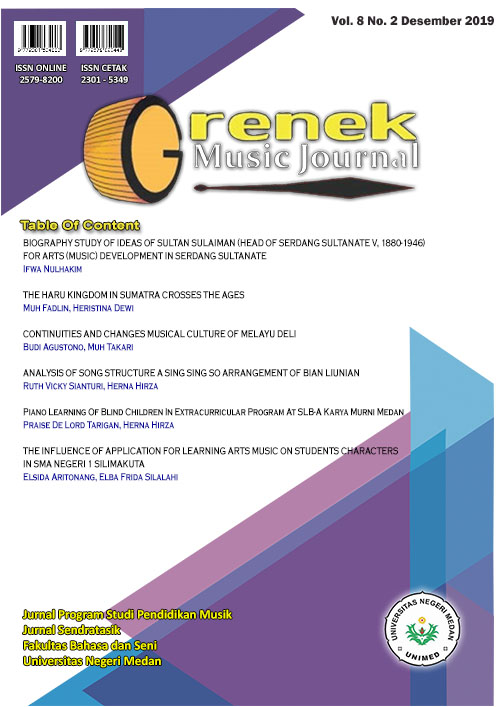CONTINUITIES AND CHANGES MUSICAL CULTURE OF MELAYU DELI
Main Article Content
Abstract
This paper analyze about continuities and changes Malay North Sumatra musical culture, with historical and ethnomusicological approach. We use the evolution theory, and qualitative methods in this research. Malay music North Sumatran begun in the early of Malay culture, in 1300 B.C. By this time to the first century, Malay musical culture basic on animism and dynamism, which use to ceremony activities. In firs to thirteen century Hinduism and Buddhism come to Malay culture. In this era musical culture from Hinduism and Buddhism absorbed by Malay North Sumatran, in the form as follows: raga and tala influence, some instrumets from India as tabla, mrdanga, sarenggi, and so on. Then, 13th century Islam adopted by North Sumatran in musical culture. The concep One God and adat bersendikan syarak, syarak bersendikan kitabullah has been make the main role in custom and music. The concept maqam and iqaat adopted to Malay musical culture. Th 16th century European come to Malay World, and some musical genres adopted by Malay, as dondang sayang (from branyo Portuguese), ronggeng, popular music, and so on. Today, all of musical element fusion to Malay culture with new development aesthetics.
Article Details
Section
Grenek Music Journal

This work is licensed under a Creative Commons Attribution-ShareAlike 4.0 International License.
Authors published with the Grenek: Jurnal Seni Musik agree to the following terms:
- Authors retain copyright and grant the journal the right of first publication with the work simultaneously licensed under a Creative Commons Attribution License (CC BY-SA 4.0) that allows others to share the work with an acknowledgment of the work's authorship and initial publication in this journal.
- Authors are able to enter into separate, additional contractual arrangements for the non-exclusive distribution of the journal's published version of the work (e.g., post it to an institutional repository or publish it in a book), with an acknowledgment of its initial publication in this journal.
- Authors are permitted and encouraged to post their work online (e.g., in institutional repositories or on their website) prior to and during the submission process, as it can lead to productive exchanges, as well as earlier and greater citation of published work. (See The Effect of Open Access)
